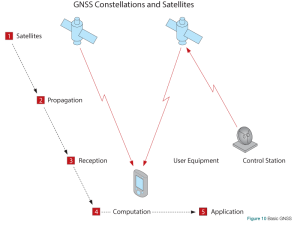Chapter 2 - Basic GNSS Concepts
“Any sufficiently advanced technology is indistinguishable from magic.” Arthur C. Clarke, British author, inventor and futurist.
In this chapter, we will introduce basic GNSS concepts. We’ll discuss more advanced concepts in the subsequent chapters.
GNSS may at first seem like magic, but the more you study and learn about it, the simpler and more elegant it becomes. The basic GNSS concept shown in Figure 10, illustrates the steps involved in using GNSS to determine time and position through to the end user application.
Step 1-Satellites: GNSS satellites orbit the earth. The satellites know their orbit ephemerides (the parameters that define their orbit) and the time very, very accurately. Ground-based control stations adjust the satellites’ ephemerides and time, when necessary.
Step 2 - Propagation: GNSS satellites regularly broadcast their ephemerides and time, as well as their status. GNSS radio signals pass through layers of the atmosphere to the user equipment.
Step 3 - Reception: GNSS user equipment receives the signals from multiple GNSS satellites then, for each satellite, recovers the information that was transmitted and determines the time of propagation, the time it takes the signals to travel from the satellite to the receiver.
Step 4 - Computation: GNSS user equipment uses the recovered information to compute time and position.
Step 5 - Application: GNSS user equipment provides the computed position and time to the end user application, for example, navigation, surveying or mapping.
In the following sections, we will discuss each of the above steps in more detail.

